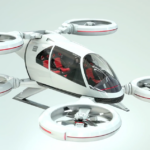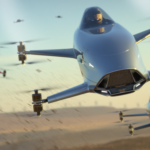Industry gathered in London last week for DSEI 2023 to discuss the importance of integration and collaboration in boosting national security and resilience across the globe.
One company showcasing how its technology is supporting this initiative was OneWeb, a developer and supplier of low Earth orbit (LEO) satellite communications technology. Hazel King, aerospace editor at FINN, sat down with Chris Moore, OneWeb’s vice president for defence and security and chief information security officer, to find out more.
Tell us a bit about your career history and why you got involved in OneWeb.
 I spent 31 years in the military as an RAF officer and ended up running the UK Defence’s global communications network and defensive cyber operations, which was fascinating and insightful. But like all good things, it had to come to an end, and I decided I wanted a second career. I didn’t want to go into another large institution, I wanted to do something energetic, fast moving, and agile. The opportunity came up to join OneWeb, which has been brilliant.
I spent 31 years in the military as an RAF officer and ended up running the UK Defence’s global communications network and defensive cyber operations, which was fascinating and insightful. But like all good things, it had to come to an end, and I decided I wanted a second career. I didn’t want to go into another large institution, I wanted to do something energetic, fast moving, and agile. The opportunity came up to join OneWeb, which has been brilliant.
Throughout my military career I’ve been connected with space in some way or other – I started off flying satellites and managing the payloads. Then later in my career I was on the other end of satellites – relying on them as my only connectivity with our HQ and occasionally, with home.
OneWeb is a pioneering company in LEO satellite communications. The benefits of LEO have long been known but it has not been economically viable, until now. Launch costs have plummeted, and manufacturing costs have become more efficient using robotics and COTS products and the ambition of AI is now a reality.
When Covid happened, one of the shareholders got into difficulties and that meant the previous version of OneWeb filed for Chapter 11 bankruptcy. As a result, the British government came in with a very generous investment which brought other shareholders on board and helped to create the OneWeb you see today.
That investment enabled us to complete our global satellite constellation of 634 satellites, which offers a live service to significant parts of the world today. We’re still building out our ground infrastructure, which should conclude early 2024 and then enable a truly global service. We are proud to be British, headquartered out of White City with 370 of our approximately 500 staff being UK based.
Does the UK government’s ownership of OneWeb help with innovation?
The UK government’s investment alongside that of other shareholders has given us the freedom to rapidly innovate – although with any space technology it must be carefully regulated. We work with the Civil Aviation Authority to make sure we launch and operate our satellites safely and sustainably, and that has been a good and constructive relationship.
The UK government has a golden share, which means that OneWeb must comply with various national security elements. That is about to change slightly because, subject to shareholder approval, we’re merging with Eutelsat at the end of September and there will be a new board composition. The UK government will still be on the board, but there will be new shareholders too, including the French government.
How will the Eutelsat partnership work?
Eutelsat is a world class geo-synchronous orbit (GEO) company – they have modern GEO satellites that are providing things like video services around the world today. The merger will bring two main benefits. Firstly, each orbit has its strengths and weaknesses, so if you combine LEO and GEO together, you get the benefits of both, especially if you create a hybrid architecture to make them work together. Users can then route their data via the most optimal means.
The second is that the merger will bring Investment for our Generation 2 satellites which will be bigger, better, more powerful and improve the capacity we have.
You have demonstrated your new person-portable terminal technology at DSEI – how is this improving the way militaries operate?
Communications has always shaped how militaries operate – from flags on a hill to radio to wire lines in the trenches in WW1. How you communicate enables and constrains commanders to how they want to configure their force elements. This revolutionary leap with LEO satcom means there is no part of the globe now where you can’t get high bandwidth with low latency – the combination of those two things means commanders now can potentially operate in very different ways. The traditional model is that you have large amounts of bandwidth at the rear of the operation and progressively less towards the tactical edge. with those at the tactical edge receiving low bandwidth and high latency which can result in a disadvantage in real time decision making. We can now bridge that gap and go straight to the edge with the same sort of performance and experience you get at home with your broadband.
How does OneWeb help improve national security and what are the challenges?
We’re positioning for the telecoms, energy, financial and banking sectors, so high end customers and governments, and security is key. We’re working very closely to understand their requirements, particularly around cyber resilience, and so far, so good.
The challenges come in many forms – it could be geopolitical, supply chain, physical security or cyber. When you have highly digital systems like we have, that presents a risk, but we are investing heavily in our security, using best practice commercial grade technology which is highly resilient – and we’re just adding bells and whistles all the time to ensure we stay ahead of the threat.
You’re trialling your technology in the Shetland and Lundy islands as part of the UK government’s ‘Very hard to Reach Premises connectivity programme, tell us more about that.
Earlier this year OneWeb was selected for two trials to connect remote communities for the UK government’s Very Hard to Reach Premises connectivity programme. The aim here is to connect the UK’s most remote homes and businesses and we have done so in the Shetlands and Lundy Island.
At OneWeb our goal has been to bridge the digital divide for communities, world over, and these successful trials, not just within the UK, but also in Canada and Greenland, showcase how OneWeb can help bring its low Earth orbit connectivity to communities and businesses that need it most.
How is OneWeb supporting and growing the future STEM workforce?
One of the things that struck me when I joined OneWeb is how demographically young the company is, and it is great to see their energy and amazing talent. We also regularly have school visits showing young people what space is about and we have strong links with academia. We are doing a lot of work to make sure that we inspire the next generation, in what is an incredibly exciting industry.
Subscribe to the FINN weekly newsletterYou may also be interested in

